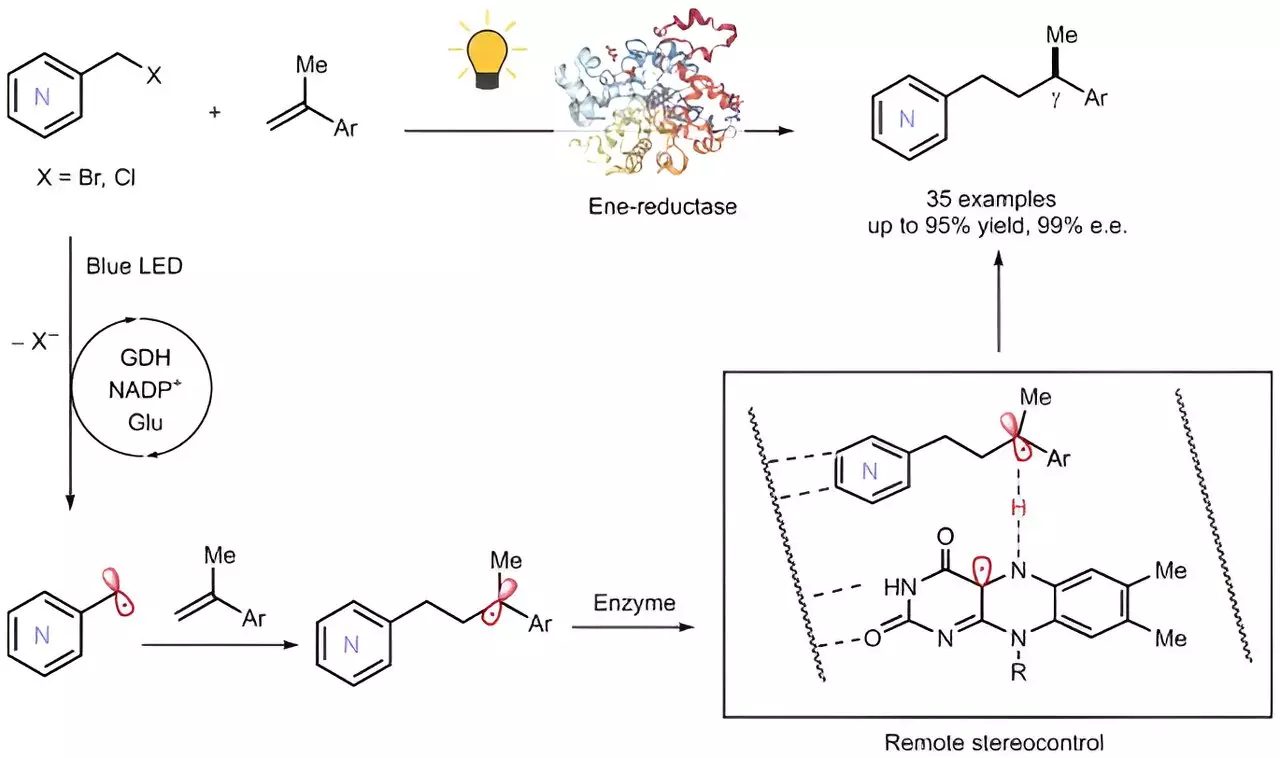A team of pioneering researchers from the Center for Advanced Bioenergy and Bioproducts Innovation (CABBI) has made remarkable progress in the complex field of molecular chemistry. Their groundbreaking focus lies on azaarenes, a type of unique molecular puzzle pieces that hold great importance in various everyday products, ranging from eco-friendly agrochemicals to essential medicines. By finding an innovative way to modify these molecules, the CABBI team has opened doors to new and industrially relevant chemical reactions, as well as sustainable energy solutions.
At the heart of their research lies the utilization of photoenzymatic systems. In essence, this involves enhancing the capabilities of nature’s tiny workers, enzymes, with the power of light. By supercharging enzymes, they can assemble or repair molecular structures in unprecedented ways. Through this breakthrough approach, the scientists have discovered novel chemical reactions that were once thought to be unattainable.
The study, which has been published in Nature Chemistry, was conducted by researchers from the University of Illinois Urbana-Champaign. The lead authors of the study are Huimin Zhao, the CABBI Conversion Theme Leader and Professor of Chemical and Biomolecular Engineering (ChBE), as well as Maolin Li, a Postdoctoral Research Associate with CABBI, ChBE, and IGB.
Although seemingly insignificant in the vast world of chemistry, azaarenes play a crucial role as building blocks in a wide array of compounds, even influencing the DNA within our cells. However, manipulating these molecules has always proven to be a challenge. Fortunately, the CABBI team has developed an ene-reductase system, which serves as a specialized molecular toolkit utilizing the ene-reductase enzyme previously utilized in Zhao’s lab. With this system, researchers have found a way to intricately modify these molecules without causing any collateral damage.
An outstanding achievement of their work is the mastery of enantioselective hydrogen atom transfer. Molecules often come in left- and right-handed versions, known as enantiomers. The team’s method allows for the selective targeting and adjustment of either enantiomer with unparalleled precision. Furthermore, through remote stereo control, they can make precise adjustments from a distance.
The discovery made by CABBI is undoubtedly a game-changer for the bioenergy sector. Biofuels and bioproducts, which are derived from plant material instead of non-renewable resources like petroleum, offer a greener and more sustainable future. As a result of this research, the range of chemical reactions and bioproducts that can be efficiently produced has expanded. Moreover, the introduction of asymmetric photocatalysis, a revolutionary technique that ensures consistency in these reactions, opens up new possibilities for producing biofuels and bioproducts from a broader range of biomass feedstocks.
The alignment of this discovery with CABBI’s goals and the broader DOE mission to advance sustainable energy and product solutions is crucial. By broadening the toolkit available for eco-friendly production, this research has the potential to catalyze breakthroughs in agrochemicals and beyond. This breakthrough also has immense potential for real-world applications, ranging from spearheading safer agricultural chemicals to leading the charge in sustainable energy.
Beyond the confines of the laboratory, the implications of this research are monumental. As the world faces environmental challenges and an urgent need for sustainable solutions, discoveries like these serve as beacons of hope. This research has the potential to facilitate economic growth, creating new industries, jobs, and products for consumers. Additionally, it can pave the way for more affordable energy sources.
By advocating for sustainable and efficient production methods, this research can contribute to the reduction of pollution and environmental degradation, leading to cleaner air and water for communities. The postdoctoral researcher on this project, Maolin Li, reflects on the transformative possibilities of their findings and the excitement for the future of sustainable energy. This research signifies much more than the nuances of chemical reactions; it represents a path towards a more sustainable and innovative future.
The groundbreaking discovery of modified azaarenes by the research team at CABBI has the potential to revolutionize molecular chemistry and pave the way for sustainable energy solutions. Through the utilization of photoenzymatic systems and the development of an ene-reductase system, researchers have unlocked novel chemical reactions and the ability to modify these molecules with unprecedented precision. With the bioenergy sector in mind, this breakthrough widens the range of efficient chemical reactions and bioproducts that can be produced, driving us towards a greener and more sustainable future.



Leave a Reply